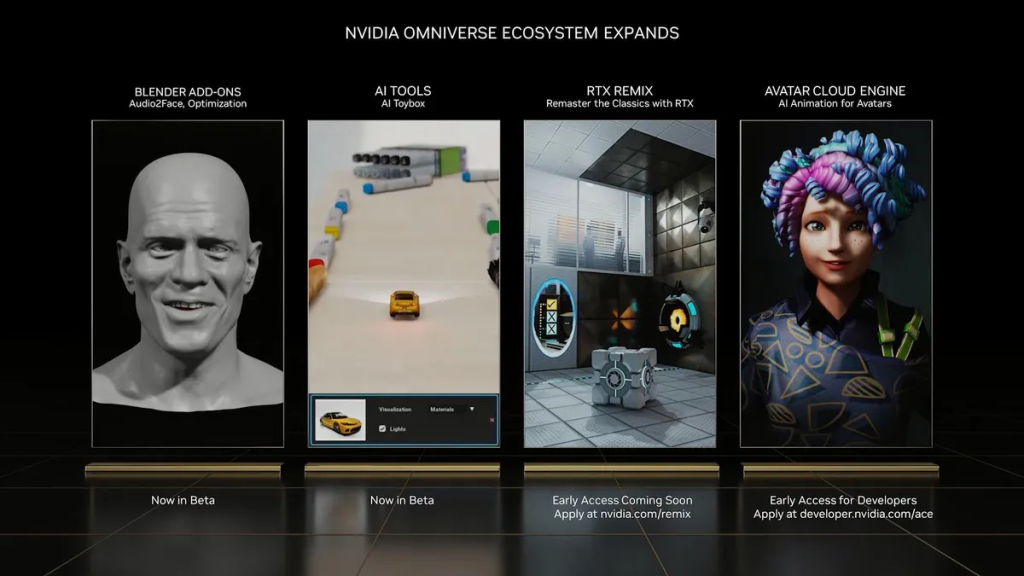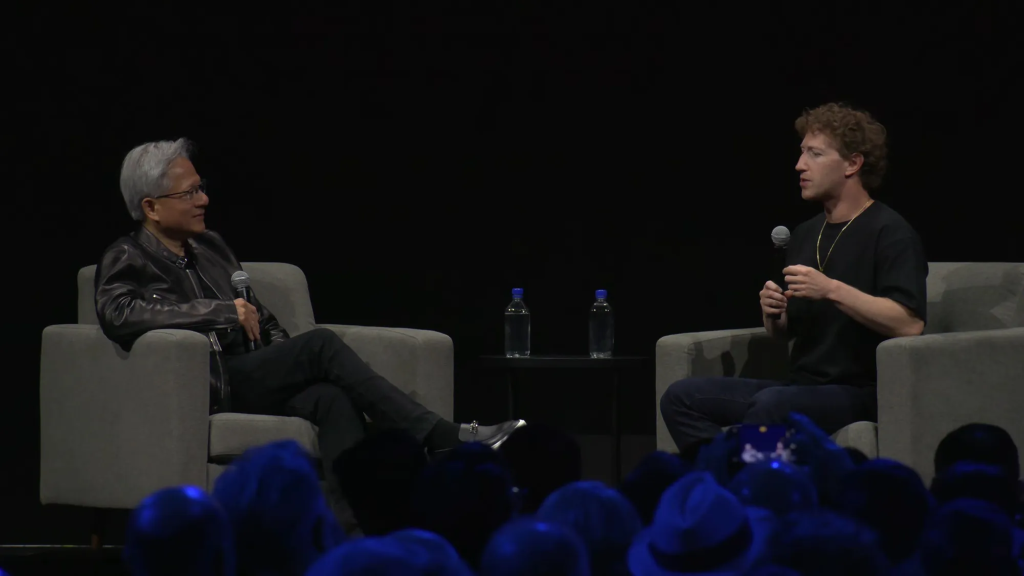
Written by: Nik Faiz Nik Ruzman, Journalist, AOPG.
When two titans of tech join forces, you know something big is on the horizon. Jensen Huang’s NVIDIA and Mark Zuckerberg’s Meta have teamed up to take digital twin technology to the next level. The partnership is all about pushing boundaries and redefining what’s possible with Artificial Intelligence (AI). Behind the scenes, there’s a fascinating blend of redemption innovation, and a quest to reshape our digital future!
The Digital Twin Resurgence! But… Why Now?
Digital twins aren’t new, but what’s fascinating is the recent shift in conversation, from focusing on digital twins of systems to creating digital replicas of… humans! NVIDIA, known for its groundbreaking GPU technology, is leading the charge with advancements that make digital twins more realistic and functional. At SIGGRAPH 2024, NVIDIA unveiled its latest digital human technologies, showcasing just how immersive and photorealistic these virtual replicas can be!
On the other hand, Meta is throwing a whopping USD $37 billion into the mix for 2024, focusing on AI data centres and hardware to support their AI operations! This hefty investment signals Zuckerberg’s shift of attention, locking his eyes from the Metaverse to something more tangible and immediately impactful.
Lofty Goals and Breakthrough Moments From the SIGGRAPH 2024

NVIDIA previewed “James,” an interactive digital human that can connect with people using emotions, humour, and other human-like interactions at SIGGRAPH 2024.
Meta and NVIDIA are aiming high with their digital twin project. The goal is to create digital twins that not only look real but can interact with their physical counterparts in real time. This involves advanced AI algorithms that can simulate behaviours and responses that can make these digital replicas incredibly lifelike!
Additionally, they want to make this technology scalable and accessible, so that even smaller businesses can benefit from it! By leveraging Meta’s vast infrastructure and NVIDIA’s AI prowess, they’re lowering the entry barriers, making digital twins more attainable for various industries.
At SIGGRAPH 2024, some major breakthroughs were highlighted. One standout was the creation of photorealistic avatars that mimic human expressions and gestures with stunning accuracy. This significant development could revolutionise customer service, training and virtual collaborations by making interactions more immersive and human-like.
Imagine seeing yourself attending other meetings, but instead of your physical self on the screen, it’s just a virtual reality of yourself taking your place as you commit to other urgent tasks at hand!
Another significant advancement was the ability of digital twins to perform real-time simulations and predictive analytics. This can be crucial for industries like healthcare and manufacturing can rely on precise decision-making that needs to be made in tight schedules!
The Tech Behind the Magic – NVIDIA’s Omniverse Just Keeps Getting Better!

NVIDIA unveils new AI advancements for Omniverse at SIGGRAPH 2024.
To realise the digital twin project, Meta and NVIDIA are harnessing several cutting-edge tools and processes. Meta’s robust AI infrastructure, including its expansive data centres and custom AI hardware, provides the foundation.
NVIDIA brings its Omniverse platform into the mix, which is pivotal for creating and managing virtual worlds that are life-like to reality. Omniverse allows for real-time collaboration and simulation which is essential for developing highly detailed and interactive digital doppelgangers!
Key technical processes include the use of advanced AI algorithms for machine learning and deep learning. These algorithms enable the digital twins to learn and adapt from real-world information, which as a result, makes them more accurate and responsive. Additionally, edge computing and IoT integration are critical. These technologies allow digital twins to collect and process data in real time from physical objects, ensuring they remain up-to-date and reflective of their physical counterparts.
This seamless integration of hardware and software, combined with the AI-driven approach, ensures that the digital twins are not just static models. This advancement of technology has paved the way for these dynamic entities, which ultimately can improve your productivity charts through the roof!
Zuckerberg’s Redemption Song

NVIDIA’s Jensen Huang and Meta’s Mark Zuckerberg sitting down together for a discussion of their latest advancements in AI development at SIGGRAPH 2024.
This isn’t just about innovation; it’s also an attempt at redemption for Zuckerberg. The Metaverse, once hyped as the next big thing, didn’t quite hit the… “Mark” (get it?).
Despite investing around USD $46 billion, the Metaverse fell short in several areas. Technologically, it was underwhelming, with graphics that seemed outdated and user engagement goals that weren’t met.
Privacy and security concerns further plagued the project, with cases of virtual property theft and social engineering manipulation which led to sensitive data exposure having been reported upon using the platform. Looks like we got ourselves an answer to why barely heard about Metaverse these days, and even if we do, it’s probably not in the view that Zuckerberg would have wanted us to see or witness.
However, Zuckerberg is now leveraging NVIDIA’s technology to redeem himself from those failures. By partnering with NVIDIA, Meta is banking on the latter’s Omniverse platform and AI capabilities to breathe life into digital twins.
This strategic alliance aims to create virtual replicas that not only look real but also interact and respond in real-time, bridging the gap between physical and digital realms. NVIDIA’s expertise in real-time collaboration and simulation ensures that these digital twins are highly detailed and immersive, setting a new standard for virtual environments for users.
While this collaboration seemed like a calculated move, many would not be able to forget the failures of Metaverse, especially with the number of resources being thrown into the bonfire. This begs the question; will this project be able to deliver on the promises of the Metaverse with a more concrete, practical application that it failed to deliver?
Looks like we will have to wait till the platter is served.
From Sci-Fi to Reality – Bold New Horizons Are Upon Us!
Looking ahead, the collaboration between Meta and NVIDIA promises to revolutionise digital twins, driving innovation across multiple sectors. This partnership exemplifies how combining strengths can lead to groundbreaking solutions. It’s also a story of resilience or perhaps even an intellectual strategic shift of long-term plan if it all goes well, as Zuckerberg aims to turn past failures into future successes.
Meanwhile, let’s take a moment to appreciate how much technology, specifically AI, has advanced in such a short span of time. The dream of bridging the gap between virtuality and humanity is inching closer to reality, thanks to advancements in digital twin technologies. What was once the stuff of science fiction is now becoming a practical tool that industries can use, digital twins + AI offer a glimpse into a future where virtual and physical reality coexist seamlessly, creating a more interconnected and intelligent world!
Of course, the main focal point here is for us to keep a close eye on what Meta and NVIDIA can offer to the table amidst to this breakthrough that they are keen to share with the world soon. The big question is, will this bold venture succeed where Metaverse faltered, or is it another grand vision facing a reality check? One thing’s for sure – the fusion of Meta and NVIDIA’s expertise is set to push the limits of what we thought possible in the realm of digital twins.
Buckle up, ladies and gentlemen, because the future is about to get a whole lot more interesting!
 (0)
(0) (0)
(0)Archive
- October 2024(44)
- September 2024(94)
- August 2024(100)
- July 2024(99)
- June 2024(126)
- May 2024(155)
- April 2024(123)
- March 2024(112)
- February 2024(109)
- January 2024(95)
- December 2023(56)
- November 2023(86)
- October 2023(97)
- September 2023(89)
- August 2023(101)
- July 2023(104)
- June 2023(113)
- May 2023(103)
- April 2023(93)
- March 2023(129)
- February 2023(77)
- January 2023(91)
- December 2022(90)
- November 2022(125)
- October 2022(117)
- September 2022(137)
- August 2022(119)
- July 2022(99)
- June 2022(128)
- May 2022(112)
- April 2022(108)
- March 2022(121)
- February 2022(93)
- January 2022(110)
- December 2021(92)
- November 2021(107)
- October 2021(101)
- September 2021(81)
- August 2021(74)
- July 2021(78)
- June 2021(92)
- May 2021(67)
- April 2021(79)
- March 2021(79)
- February 2021(58)
- January 2021(55)
- December 2020(56)
- November 2020(59)
- October 2020(78)
- September 2020(72)
- August 2020(64)
- July 2020(71)
- June 2020(74)
- May 2020(50)
- April 2020(71)
- March 2020(71)
- February 2020(58)
- January 2020(62)
- December 2019(57)
- November 2019(64)
- October 2019(25)
- September 2019(24)
- August 2019(14)
- July 2019(23)
- June 2019(54)
- May 2019(82)
- April 2019(76)
- March 2019(71)
- February 2019(67)
- January 2019(75)
- December 2018(44)
- November 2018(47)
- October 2018(74)
- September 2018(54)
- August 2018(61)
- July 2018(72)
- June 2018(62)
- May 2018(62)
- April 2018(73)
- March 2018(76)
- February 2018(8)
- January 2018(7)
- December 2017(6)
- November 2017(8)
- October 2017(3)
- September 2017(4)
- August 2017(4)
- July 2017(2)
- June 2017(5)
- May 2017(6)
- April 2017(11)
- March 2017(8)
- February 2017(16)
- January 2017(10)
- December 2016(12)
- November 2016(20)
- October 2016(7)
- September 2016(102)
- August 2016(168)
- July 2016(141)
- June 2016(149)
- May 2016(117)
- April 2016(59)
- March 2016(85)
- February 2016(153)
- December 2015(150)
